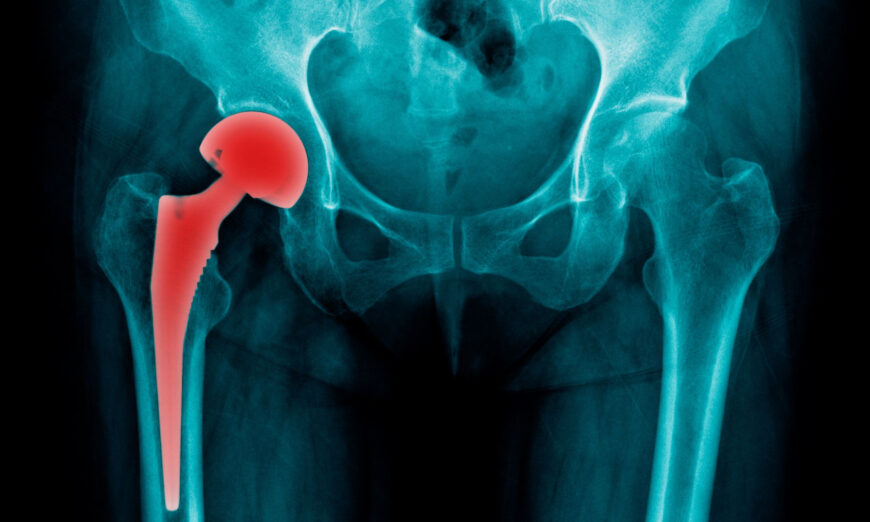![]() Hip replacement surgery is one of the most common orthopedic surgeries performed in the United States each year, and has brought relief to millions who have suffered from painful conditions like osteoarthritis or rheumatoid arthritis.
Hip replacement surgery is one of the most common orthopedic surgeries performed in the United States each year, and has brought relief to millions who have suffered from painful conditions like osteoarthritis or rheumatoid arthritis.
But despite developments made in the past few decades, the procedure still carries potentially serious risks for some patients, especially those who received metal-on-metal (MOM) hip implants.
MOM implants are those in which the “ball” and “socket” of the hip joint are both made from an alloy that includes cobalt and chromium. With the friction that occurs from normal wear and tear, metal particles are shed into the surrounding tissues and bloodstream. An accumulation of these particles can result in harmful metallosis, (metal toxicity), or cobaltism from shed cobalt particles, which can lead to symptoms ranging from tissue death and bone loss to neurological complications that mimic Alzheimer’s disease.
A Brief History of Hip Replacements
Total hip replacement (THR) surgery (also called total hip arthroplasty) has been around for almost a century. It’s currently considered to be among the safest and most successful orthopedic surgeries. According to the American Academy of Orthopedic Surgeons, more than 450,000 THR surgeries are performed annually in the United States. Traditional hip replacements have generally used a metal “ball” along with a polyethylene (plastic) liner or “socket.” More recently, different combinations of metal alloys, crosslinked polyethylene, and ceramics have become the most widely used.
Metal-on-metal (MOM) hip implants were first used in 1966 and quickly gained in popularity. They were thought to have several advantages over the conventionally used metal-on-polyethylene implants, including less “wear and tear,” greater durability, and the possibility of using larger femoral heads (the “ball” part of the ball-and-socket), which could provide greater stability and range of motion in the patient, as well as a lower chance of dislocation. This made metal-on-metal implants an especially attractive option for younger and highly active patients.
Further design developments led to the use of MOM implants made from a cobalt-chromium alloy, and the use of these particular MOM implants really took off in the 2000s, with more than 600,000 Americans receiving metal-on-metal hip implants between 2006 and 2012, before their use began to drop sharply due to product recalls, lawsuits, and an increased awareness of the serious risks associated with them. These risks include heart and thyroid problems, as well as troubling neurological symptoms, among others.
Finding the Problem
Dr. Steven Tower, a 30-year orthopedic surgeon who specializes in hip, knee, and shoulder surgeries, has pioneered research on the risks of cobalt-containing implants. His passion for investigating this issue and sharing the results of his research was spurred by his own horrific experience with a failed metal-on-metal hip implant.
After having his hip replaced in 2006, he quickly began to experience troubling symptoms.
“When I became seriously ill in 2007, I suspected cobalt. The hip had to come out because there was so much damage to the tissue around the hip. I was also developing retinal damage, in addition to some really annoying tinnitus and deafness,” Tower told The Epoch Times.
He also experienced sleep disturbance, mood instability, imbalance, and stiffening of the heart (diastolic cardiomyopathy).
Soon after MOM replacement implants were introduced into the orthopedic marketplace, it became clear that they were linked to unexpected, adverse reactions. They failed at a much higher rate than other types of implants—about six times as often—and the friction between the ball and socket resulted in metal “debris” being released into the surrounding tissue and bloodstream. This buildup of cobalt or other metals in the blood can cause damage to the heart, brain, eyes, ears, and other organs.
The Problematic Origin of MOM Implants
In case you’re wondering how these high-risk devices came to be implanted in thousands of patients, to begin with—the New England Journal of Medicine reports that they were able to be brought to market through a regulatory loophole known as the 510(k) process.
Through this pathway, certain high-risk medical devices—which would normally be required to undergo clinical testing demonstrating their safety and effectiveness—can be brought to market if they can demonstrate “substantial equivalence” to products that have already been approved by the U.S. Food and Drug Administration.
The kicker here is that the “substantial equivalence” does not have to be to devices that are currently in use and have a proven track record of safety and effectiveness. New products can be “substantially equivalent” to those which had been voluntarily recalled or shown to be unsafe or ineffective.
Phased Out but Still in Use
Even though metal-on-metal hip replacements were gradually either recalled or phased out and have not been used in the United States since May 2016, it’s estimated that about one million were implanted in Americans before they were fully off the market.
Some hip resurfacing implants still use cobalt-chromium parts, and so do certain other types of implants including knee and shoulder.
The only remedy for severe cases of cobaltism or metallosis is revision surgery, in which the metal parts are removed and replaced with non-metal alternatives. Unfortunately, revision surgery is often riskier and more expensive than the original surgery.
Bone loss following the first surgery can make it more difficult for the new implants to anchor well. In less severe cases though, chelation therapy may be effective in reducing levels of both cobalt and chromium ions in the blood. Support for that treatment comes from several case reports, including one titled “N-Acetyl-Cysteine Reduces Blood Chromium and Cobalt Levels in Metal-on-Metal Hip Arthroplasty,” published in the June 2020 issue of Arthroplasty Today.
The Cobalt Conundrum
Cobalt toxicity resulting from MOM hip implants is of particular concern because symptoms from elevated cobalt levels are often neurological, resembling Alzheimer’s or dementia, and can mimic those resulting from other types of toxicity.
This makes cobaltism easy to misdiagnose, or misattribute to the natural effects of aging, explains Tower.
“The most commonly noted symptoms are a tremor, which the patients may not even notice. Very common is a loss of mental acuity, and fatigue is another big one. But the problem with symptoms like that is, they’re very common in aging populations. The question is, do they feel that what they’re experiencing is beyond what they would expect from aging?”
Safety thresholds for cobalt concentrations in the blood are not widely agreed upon. According to the Mayo Clinic, normal blood levels should be under 1.8 micrograms/liter (mcg/L). At over 2.0 micrograms, monitoring is recommended, and 5.0 or more is considered toxic. In patients with cobalt-chromium prosthetic hip implants, cobalt concentrations in their blood can rise to many times above levels considered to be safe.
Three cases presented at the ACR Winter Symposium on Jan. 29, 2014, of patients who had undergone hip replacement surgery using either metal-on-metal or metal-on-polyethylene implants showed cobalt blood concentrations ranging from 20.0 mcg/L to 287.6 mcg/L—the latter being almost 160 times over the safety threshold.
Robert D. Bunning, M.D., FACP, FACR, who presented the cases, told the audience that a remarkable aspect of each of the patients was that “hip pain was not a prominent feature.” Rather, varied symptoms of cobaltism included serious heart and thyroid complications, fatigue, and cataracts.
Neurological Consequences
Subsequent research has found associations between cobalt toxicity and neurological disorders.
A review of research related to metal toxicity following hip implants, published in the Sept-Oct 2014 edition of Clinical Toxicology found that, out of 18 individual cases, “The reported systemic features fell into three main categories: neuro-ocular toxicity (14 patients), cardiotoxicity (11 patients) and thyroid toxicity (9 patients). Neurotoxicity was manifest as peripheral neuropathy (8 cases), sensorineural hearing loss (7), and cognitive decline (5); ocular toxicity presented as visual impairment (6). All these neurological features, except cognitive decline, have been associated with cobalt poisoning previously.”
Other studies also highlighted depression and memory loss following cobalt toxicity.
It’s not hard to see how, especially in elderly patients, toxicity resulting from cobalt-chromium implants could easily be mistaken for Alzheimer’s or dementia, for which memory loss and difficulty concentrating are key features.
And although MOM hip replacements have been in the spotlight, other prosthetic implants also contain cobalt-chromium and may pose some level of risk, warned Tower.
“We’ve come to recognize all these same issues can occur with any cobalt-chrome orthopedic implant,” he said.
This poses a significant public health concern when you consider that 20 million people in North America currently have some type of cobalt-chrome arthro-prosthetic (joint) implant.
An Individualized and Unpredictable Danger
While some individuals seem to tolerate cobalt-chromium implants well, many others have adverse reactions, and it’s impossible to foretell how any given person will react, said Tower.
“There’s also individual variability in what different cobalt levels will do to an individual, and this has to do with the immune system. Some are very sick with modest elevations—other individuals had extremely high blood cobalt levels and didn’t see any systemic toxicity issues.
“We’re dealing with a spectrum disorder here—we’ve learned about its existence from relatively extreme cases such as my own, or where people die or become deaf or blind. But for every case report, how many cases were there of similar severity that were never written up?”
There may also be many cases misdiagnosed as other conditions. Because cobalt exposure can affect different people in varied ways, both patients and health care providers need to be aware of the symptoms that could indicate cobalt poisoning following joint replacement surgery.
According to the University of Rochester Medical Center, symptoms of cobalt poisoning could include fatigue, weakness, peripheral neuropathy, hearing loss, visual loss, cognitive decline, cardiomyopathy, and/or hypothyroidism. Pain, disrupted sleep, and mood disorders have also been noted as symptoms.
Cobalt levels can be easily detected by either blood or urine tests, and many cases of cobalt metallosis can be treated, especially if detected early on. Those who have had cobalt-containing implants should be aware of these symptoms so that they can contact their doctors immediately if problems arise. As Tower notes, “Who knows how many people have had some effect from cobalt exposure that has limited their ability to function independently? My experience as patient, surgeon, and researcher indicates orthopedic-implant cobaltism is common, treatable, and preventable.”










